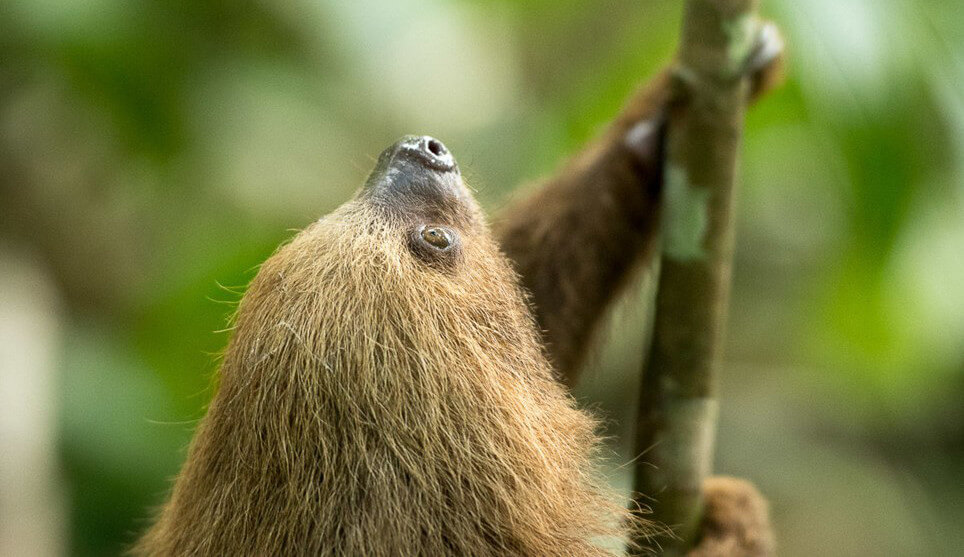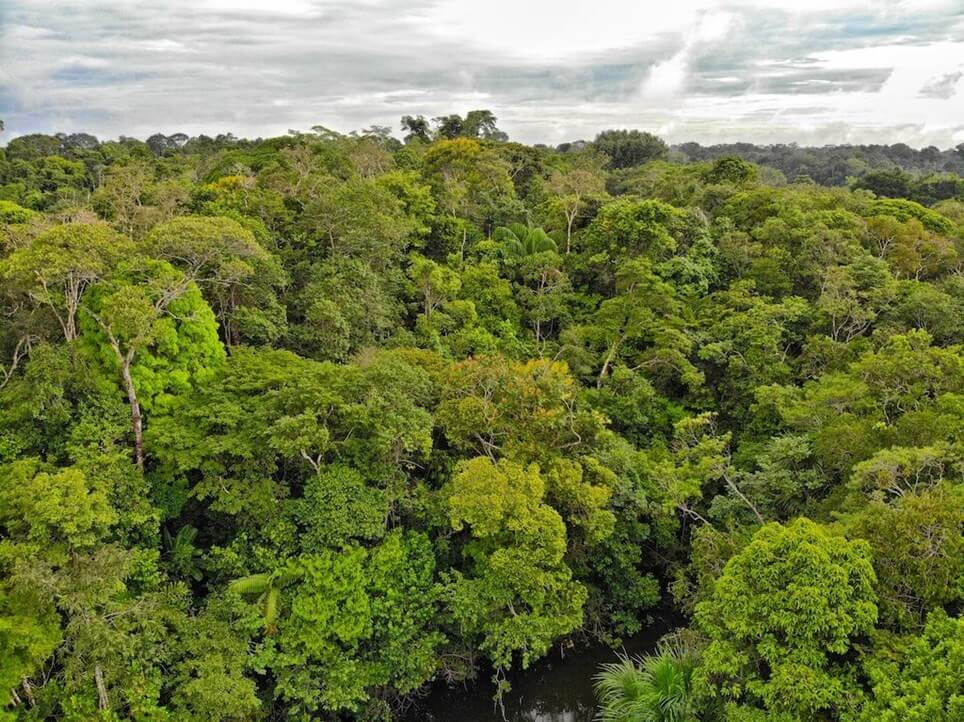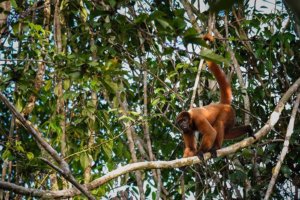Casual & Nauta Caño
 Our adventure began early morning. At dawn, before breakfast we boarded eagerly onto local watercraft in anticipation to explore a tributary of the Amazon River. The air felt fresh and cool in our faces as we sped into the jungle waterway, and it was not long before our expert naturalist guides began indicating local wildlife to observe and photograph. The skiff drivers negotiated the waters with ease, putting us front and center as possible to pure Amazonian wilderness. Our morning endeavors were followed in turn with a fantastic breakfast aboard Delfin II.
Our adventure began early morning. At dawn, before breakfast we boarded eagerly onto local watercraft in anticipation to explore a tributary of the Amazon River. The air felt fresh and cool in our faces as we sped into the jungle waterway, and it was not long before our expert naturalist guides began indicating local wildlife to observe and photograph. The skiff drivers negotiated the waters with ease, putting us front and center as possible to pure Amazonian wilderness. Our morning endeavors were followed in turn with a fantastic breakfast aboard Delfin II.
Later that day we explored Casual Trail on foot. Exploration adjacent to the might Amazon was absolutely fantastic. In addition to all the interesting creatures we saw, it felt great to stretch our legs as we trekked through the dense vegetation, deeper toward the day’s rich discoveries.
Yanayacu, Pucate & Amazon Natural Park
 On our second morning of exploration, we visited the called Yanayacu and Pucate Tributaries. Exploring from the vantage of expedition watercraft is truly enjoyable experience! All we need to do is sit back and let the breeze caress our faces while we take in the fantastic scenery. Guides will stop occasionally to point out findings, things and creatures so subtly placed you’d think it impossible for human eyes to detect.
On our second morning of exploration, we visited the called Yanayacu and Pucate Tributaries. Exploring from the vantage of expedition watercraft is truly enjoyable experience! All we need to do is sit back and let the breeze caress our faces while we take in the fantastic scenery. Guides will stop occasionally to point out findings, things and creatures so subtly placed you’d think it impossible for human eyes to detect.
During the afternoon we visited a local medicine woman to learn about the medicinal culture of this area and the plants used by those living in the jungle. Following, we walked through more tropical rainforest, along trails and suspension bridges. What we were provided today was an in-depth look into life within this dynamic ecosystem, and to take it all in from the vantage of an authentic suspension bridge made the experience all the more total!
Marañon Ucayalli Rivers & San Jorge Community
 Today we had the special opportunity to visit a small community adjacent to the San Jorge River. It is an eye-opening experience to get to visit the people who live in such remote areas. It is fascinating to see how closely they have learned to live with their environment, and how little they need to be happy. They received us with open arms and big smiles. We got the chance to see their homes, the school, and to learn about what they are doing to improve their living through a local organization called Minga Peru.
Today we had the special opportunity to visit a small community adjacent to the San Jorge River. It is an eye-opening experience to get to visit the people who live in such remote areas. It is fascinating to see how closely they have learned to live with their environment, and how little they need to be happy. They received us with open arms and big smiles. We got the chance to see their homes, the school, and to learn about what they are doing to improve their living through a local organization called Minga Peru.
Later in the morning and afternoon we visited and explored more of the many tributaries of the Amazon. One of the big highlights for today was to see one of the smallest primates in the world, the pygmy marmoset. The little monkeys posed for us among the open branches and close to the water.
Belluda Creek and Dorado River
Our day began with a pre-breakfast exploring session along the Ucayali River. Several species of birds were getting ready to take off from their evening perch. A myriad of calls from the surrounding wildlife filled the air. It was a fitting way to start another great morning in the Amazon.
The cool Amazon breeze this morning allowed us to enjoy the colors of the birds. We returned for breakfast back on board Delfin II. Our after-breakfast activities were soon waiting for us. Kayaking and boat rides were the options for Belluda creek, a small tributary of the Ucayali River.
 The exploration was enjoyed by all, as we were rewarded with sightings of Saddleback tamarins, flocks of blue and yellow macaws, saki monkeys, and many other animal species, which our guests wasted no time capturing on camera.
The exploration was enjoyed by all, as we were rewarded with sightings of Saddleback tamarins, flocks of blue and yellow macaws, saki monkeys, and many other animal species, which our guests wasted no time capturing on camera.
Back on board, we cruised to our afternoon destination of Dorado River. This tributary of the Ucayali is known for the distinct coloration of its water. The black waters work as a mirror and when the sun begins to set, while its earlier yellow color lends the sensation of navigating through gold.
We ended our day exploring this river close to sunset. After enjoying more sightings of primates, our naturalist brought out the spotlights. With this we were able to spot different species of caimans that dwell in this river.
It was a perfect way to end another day in this South American paradise.
Pacaya River and Magdalena Lagoon
Our day began with a gentle rain. It didn’t discourage us to go out and explore the Pacaya Samiria Wildlife Reserve. Our plan was to leave just at sunrise and go deep inside the reserve.
 We loaded the skiff and cruised along the Pacaya River. There was a section of varsea forest very interesting. It was covered with water lilies and different species of water plants. The aquatic birds like wattle jacanas, horned screamers and great egrets were all gathered looking for their meal.
We loaded the skiff and cruised along the Pacaya River. There was a section of varsea forest very interesting. It was covered with water lilies and different species of water plants. The aquatic birds like wattle jacanas, horned screamers and great egrets were all gathered looking for their meal.
We stopped close to a ranger station to have breakfast. Our galley had prepared a delicious menu for us. We recharged our energies to continue exploring the Pacaya River.
Supay, Iricahua, and Yarapa River
Our final day exploring the Upper Amazon began with a lovely sunrise. Delfin II spent the night near the mouth of the Supay River. We could hear the call of birds, so we loaded onto watercraft to go and explore this river before breakfast.
Different species of birds were sighted here. Flocks of sand-colored nighthawks were spotted resting in shrubs alongside black-crowned night herons. It was spectacular getting to see them take off from their perch.
 During breakfast Delfin II repositioned next to the mouth of another tributary of the Iricahua River. This narrow river was a highpoint of our expedition. Red and green macaws were seen by our guests and in the company of other characteristic species like blue and yellow macaws, the white-eared jacamar, masked crimson tanagers, and several others.
During breakfast Delfin II repositioned next to the mouth of another tributary of the Iricahua River. This narrow river was a highpoint of our expedition. Red and green macaws were seen by our guests and in the company of other characteristic species like blue and yellow macaws, the white-eared jacamar, masked crimson tanagers, and several others.
After lunch, we relocated to Yarapa River. This was the last place of our voyage to explore on watercraft. Nature was kind to us as she allowed many other species of animals and birds to show up for our delight.
As the sun began to set, we all gather back on board to share our thoughts of how great it had been these seven days exploring the amazing Upper Amazon.








